Paper Observatory Domes
Imagine yourself in the late 1800's. Newtonian physics reigned (along with Queen Victoria) and had yet to face the challenges of quantum physics. God was still the master clock maker and this was one of the golden ages of Astronomy. The US Naval Observatory was established in 1844; the Greenwich Observatory completed its new 28" refractor in 1893. Using new knowledge from physics and chemistry, people sought to understand the rules and ordering of the universe.
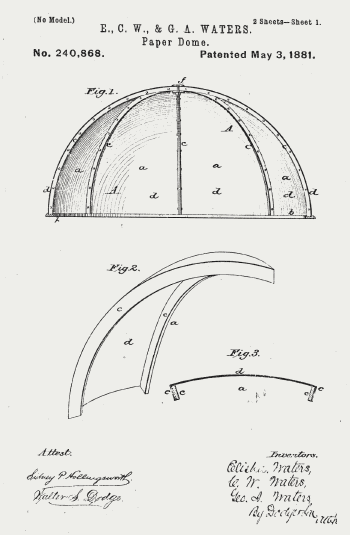 At the same time terrestrial technology was expanding rapidly. Edison was busy inventing the
Phonograph and the Light Bulb (1877-79). Cast and wrought iron emerge as major structural
materials (the Crystal Palace in England was built in 1851, and cast iron facade buildings abound in NY City in the 1870's and 80's).
At the same time terrestrial technology was expanding rapidly. Edison was busy inventing the
Phonograph and the Light Bulb (1877-79). Cast and wrought iron emerge as major structural
materials (the Crystal Palace in England was built in 1851, and cast iron facade buildings abound in NY City in the 1870's and 80's).
Lightweight construction materials were yet impractical. Aluminum was expensive, still awaiting the invention of the Hall process in 1886 to turn it into a commodity item. In this environment the thought of applying the same paper and wood-frame technology, that was used in boat building, to observatory domes was probably a lot more appealing than it might seem today. Thus in 1878, the first of a series of paper observatory domes was built by E. Waters & Sons, (the 19th century paper boat manufacturers in Troy NY.) It was for a local observatory donated to the Rensselaer Polytechnic Institute in Troy by the Proudfit family. Professor Greene, of RPI, provides the following rationale for paper construction:
"I ascertained that a dome of the dimensions required, constructed in any of the methods in common use, would weigh five to ten tons, and require the aid of cumbersome machinery to move it. It therefore occurred to me to obviate this objection by making the frame-work of wood, of the greatest lightness consistent with the requisite strength, and covering it with paper of a quality similar to that used in the manufacture of paper boats; the principal advantages in the use of these materials being that they admit of great perfection of form and finish, and give extreme lightness, strength, and stiffness in the structure....... "
The construction method was not unlike that used in boat manufacture. A thick linen paper
manufactured by a Crane paper mill in Westfield, MA was formed over wooden molds. The dome's
wooden framework was pre-mounted on the mold, much as gunwales and keels were in
boat molds. A difference was, of course, that the dome was formed of multiple sections each
individually manufactured.
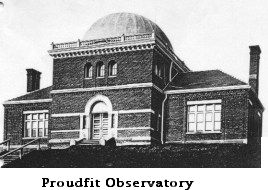
Finished sections were bolted together, the joints being weatherproofed
by sandwiching a double thickness of heavy cotton cloth saturated with white lead between adjacent
panels. Although Professor Greene may seem to have laid claim to inventing this technology,
Elisha, Clarence, and George Waters obtained a US patent for Paper Observatory Domes in 1881.
The Proudfit observatory dome at RPI, according to Professor Greene, was 29 feet in diameter and consisted of 16 sections plus a 4-foot wide shuttered opening for the telescope. The estimated total weight of the dome was 4000 pounds of which paper alone accounted for approximately 1000 pounds. The dome was supported by six eight-inch balls, which moved between grooved iron tracks and could, "be easily revolved by a moderate pressure applied directly without the aid of machinery." The dome lasted for over twenty years and was removed, not because of decay, but to convert the building to other uses in 1889.
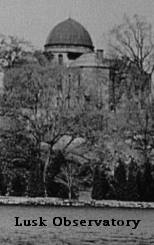
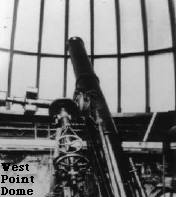 A series of domes was built by Waters thereafter. In 1881 the largest of their domes was placed on the new Lusk Observatory at the U.S. Military Academy in West Point. It was slightly over 30 feet in diameter and contained over 2,000 pounds of paper. The paper was from 3/8" to 1/2 inch thick and had the light wood framework similar to that shown in the Waters patent. The interior
photograph of the dome also shows the basic wood-frame structure. According to the publication Paper World of 1881,
A series of domes was built by Waters thereafter. In 1881 the largest of their domes was placed on the new Lusk Observatory at the U.S. Military Academy in West Point. It was slightly over 30 feet in diameter and contained over 2,000 pounds of paper. The paper was from 3/8" to 1/2 inch thick and had the light wood framework similar to that shown in the Waters patent. The interior
photograph of the dome also shows the basic wood-frame structure. According to the publication Paper World of 1881,
"It weighs only 1/10 th as much as a copper dome of equal size. It is expected that the paper will act as a nonconductor of heat and electricity, will maintain a uniform temperature within the building, and will prevent any electrical disturbance from destroying the accuracy of the instruments."
The West Point Dome survived without any major repairs into the 1920's. In 1924 more paper and shellac was added, which preserved it for 15 years until more leaks and cracks appeared. Interest in astronomy waned and the last formal instruction took place in 1934. Thus the dome and observatory gradually fell into disrepair and were eventually dismantled in 1958-59. The dome remained the pride of the US Paper Industry, which featured it in a display in the Montreal World's Fair a few years later.
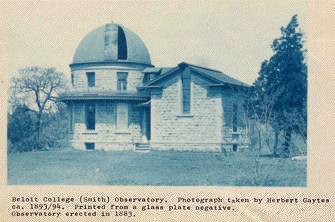 In 1883 the Smith Observatory was erected at Beloit College in Beloit, Wisconsin utilizing a dome
of smaller dimension. According to the memoirs of the College President at the time, it was unique as it was the college's first
building which was an individual gift and the first devoted exclusively to science.
In 1883 the Smith Observatory was erected at Beloit College in Beloit, Wisconsin utilizing a dome
of smaller dimension. According to the memoirs of the College President at the time, it was unique as it was the college's first
building which was an individual gift and the first devoted exclusively to science. "Modest in size, it is, with its fine Alvin Clark lens mounted by Warner and Swazey and its other equipment,
excellently suited to college needs."
It was one of the first (if not the first) mounts built by Warner and Swasey which was subsequently acquired by the Smithsonian for their archives. (Warner and Swasey supplied a substitute mount to replace it.)
According to Beloit College, the observatory was demolished to make room for other construction in 1973. The observatory was presumably not in use at the time as the telescope itself was purchased in 1967 by the TV personality and astronomy enthusiast, Dave Garroway. (He subsequently sold the telescope to Keystone College in Nothern Pennsylvania in 1971). We do not know if the paper dome was still there in 1973.
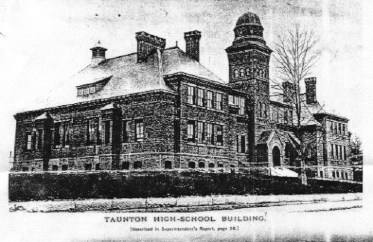 Other domes credited to Waters were at a high school in Taunton MA (built in 1885 and removed
in 1918 when remodeling was done), Columbia College in New York City, and at the Brooklyn
Polytechnic Institute. The Columbia dome was apparently constructed between 1866 (when Dr. Barnard, the president of Columbia identified the need in an annual report) and 1889 when it was cited as an accomplishment during Dr. Barnard's tenure. My guess is that the archives of Columbia and Brooklyn Poly might yield more information and perhaps photos.
The illustration we show is from a text discussing the history of Columbia. It is from this period and shows what appears to be an observatory dome perched atop one of the buildings near the center of the illustration. We have no information on the life of this dome, nor the life of the astronomy prgram.
Other domes credited to Waters were at a high school in Taunton MA (built in 1885 and removed
in 1918 when remodeling was done), Columbia College in New York City, and at the Brooklyn
Polytechnic Institute. The Columbia dome was apparently constructed between 1866 (when Dr. Barnard, the president of Columbia identified the need in an annual report) and 1889 when it was cited as an accomplishment during Dr. Barnard's tenure. My guess is that the archives of Columbia and Brooklyn Poly might yield more information and perhaps photos.
The illustration we show is from a text discussing the history of Columbia. It is from this period and shows what appears to be an observatory dome perched atop one of the buildings near the center of the illustration. We have no information on the life of this dome, nor the life of the astronomy prgram.
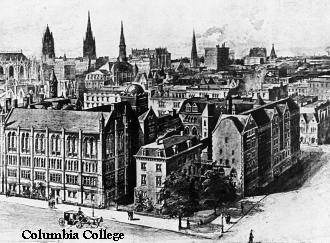 The obituary of Elisha Waters would have us add the tantalizing phrase "and other institutions" to the previous paragraph. This whets the appetite of an historian, but so far we not been able to document any additional domes to add to the list.
The obituary of Elisha Waters would have us add the tantalizing phrase "and other institutions" to the previous paragraph. This whets the appetite of an historian, but so far we not been able to document any additional domes to add to the list.
It was brought to our attention that the Onion Dome , built in 1893, at the Greenwich Observatory in England was constructed of paper mache over an iron framework. It was damaged in an air raid in 1940 and eventually stripped of its covering in 1944. If there was one such dome, there were probably more. While it certainly was not the work of Waters and Sons, it falls into the main river of technology flowing through The Age of Paper .
We got word from Dr. Bill Samson of the Mills Observatory in Dundee, Scotland that they have a 7 meter paper observatory dome dating from 1935 that houses a venerable 10" refracting telescope made by Thomas Cooke in 1871. According to them the dome was provided by Grubb-Parsons and consists of paper mache & a steel frame. It is still in active use, although the paper has now been covered with fabric as well and further coats of paint. (A similar preservation was used on the West Point dome before its eventual demise). Contrary to the information on the Mills site, there is not a paper dome at the University of Toronto's Observatory. It may have been initially planned with one in mind, but it was constructed with a more traditional copper dome.
Return to Main Page for more information on other 19th Century paper oddities and technology.